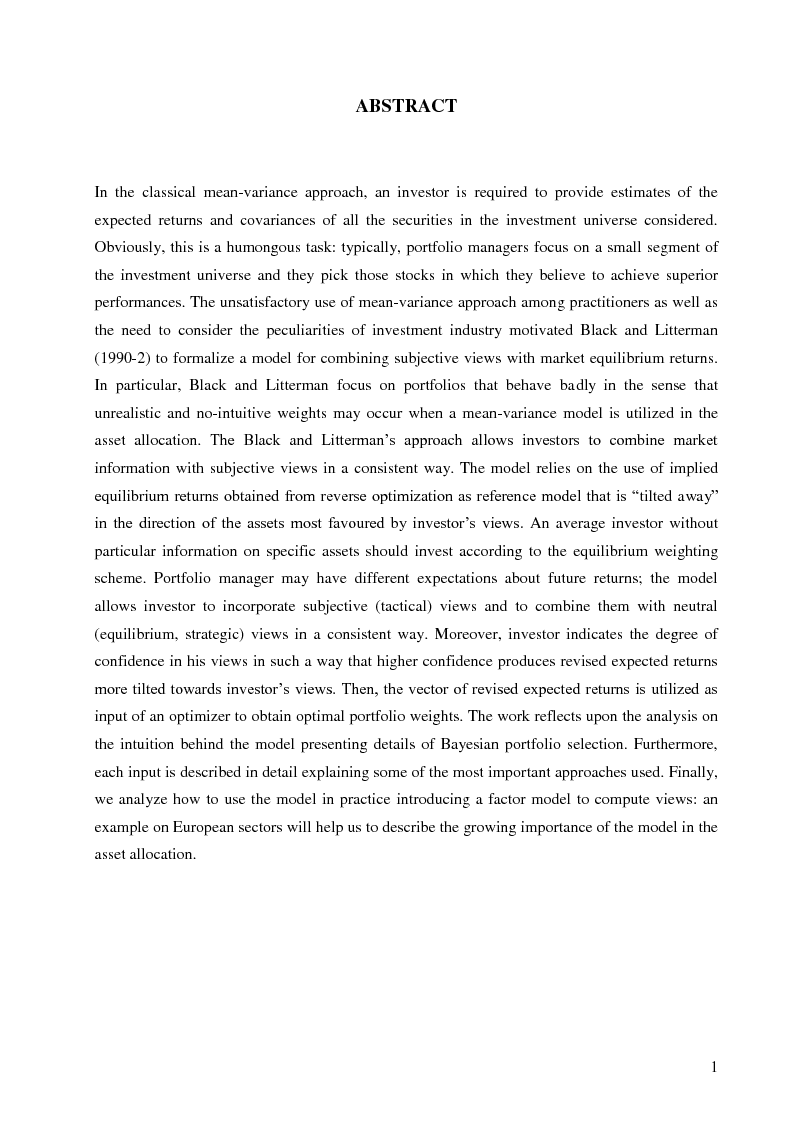A Practical Approach to the Black and Litterman Model: An Example on European Sectors
In the classical mean-variance approach, an investor is required to provide estimates of the expected returns and covariances of all the securities in the investment universe considered. Obviously, this is a humongous task: typically, portfolio managers focus on a small segment of the investment universe and they pick those stocks in which they believe to achieve superior performances. The unsatisfactory use of mean-variance approach among practitioners as well as the need to consider the peculiarities of investment industry motivated Black and Litterman (1990-2) to formalize a model for combining subjective views with market equilibrium returns. In particular, Black and Litterman focus on portfolios that behave badly in the sense that unrealistic and no-intuitive weights may occur when a mean-variance model is utilized in the asset allocation. The Black and Litterman’s approach allows investors to combine market information with subjective views in a consistent way. The model relies on the use of implied equilibrium returns obtained from reverse optimization as reference model that is “tilted away” in the direction of the assets most favoured by investor’s views. An average investor without particular information on specific assets should invest according to the equilibrium weighting scheme. Portfolio manager may have different expectations about future returns; the model allows investor to incorporate subjective (tactical) views and to combine them with neutral (equilibrium, strategic) views in a consistent way. Moreover, investor indicates the degree of confidence in his views in such a way that higher confidence produces revised expected returns more tilted towards investor’s views. Then, the vector of revised expected returns is utilized as input of an optimizer to obtain optimal portfolio weights. The work reflects upon the analysis on the intuition behind the model presenting details of Bayesian portfolio selection. Furthermore, each input is described in detail explaining some of the most important approaches used. Finally, we analyze how to use the model in practice introducing a factor model to compute views: an example on European sectors will help us to describe the growing importance of the model in the asset allocation.
CONSULTA INTEGRALMENTE QUESTA TESI
La consultazione è esclusivamente in formato digitale .PDF
Acquista

CONSULTA INTEGRALMENTE QUESTA TESI
La consultazione è esclusivamente in formato digitale .PDF
Acquista
Informazioni tesi
| Autore: | Andrea Flori |
| Tipo: | Laurea II ciclo (magistrale o specialistica) |
| Anno: | 2009-10 |
| Università: | Università degli Studi di Siena |
| Facoltà: | Economia |
| Corso: | Finanza |
| Relatore: | Duccio Fineschi |
| Lingua: | Inglese |
| Num. pagine: | 127 |
Forse potrebbe interessarti la tesi:
Il modello di Black-Litterman; un’applicazione empirica
FAQ
Come consultare una tesi
Il pagamento può essere effettuato tramite carta di credito/carta prepagata, PayPal, bonifico bancario.
Confermato il pagamento si potrà consultare i file esclusivamente in formato .PDF accedendo alla propria Home Personale. Si potrà quindi procedere a salvare o stampare il file.
Maggiori informazioni
Perché consultare una tesi?
- perché affronta un singolo argomento in modo sintetico e specifico come altri testi non fanno;
- perché è un lavoro originale che si basa su una ricerca bibliografica accurata;
- perché, a differenza di altri materiali che puoi reperire online, una tesi di laurea è stata verificata da un docente universitario e dalla commissione in sede d'esame. La nostra redazione inoltre controlla prima della pubblicazione la completezza dei materiali e, dal 2009, anche l'originalità della tesi attraverso il software antiplagio Compilatio.net.
Clausole di consultazione
- L'utilizzo della consultazione integrale della tesi da parte dell'Utente che ne acquista il diritto è da considerarsi esclusivamente privato.
- Nel caso in cui l’utente che consulta la tesi volesse citarne alcune parti, dovrà inserire correttamente la fonte, come si cita un qualsiasi altro testo di riferimento bibliografico.
- L'Utente è l'unico ed esclusivo responsabile del materiale di cui acquista il diritto alla consultazione. Si impegna a non divulgare a mezzo stampa, editoria in genere, televisione, radio, Internet e/o qualsiasi altro mezzo divulgativo esistente o che venisse inventato, il contenuto della tesi che consulta o stralci della medesima. Verrà perseguito legalmente nel caso di riproduzione totale e/o parziale su qualsiasi mezzo e/o su qualsiasi supporto, nel caso di divulgazione nonché nel caso di ricavo economico derivante dallo sfruttamento del diritto acquisito.
Vuoi tradurre questa tesi?
Per raggiungerlo, è fondamentale superare la barriera rappresentata dalla lingua. Ecco perché cerchiamo persone disponibili ad effettuare la traduzione delle tesi pubblicate nel nostro sito.
Per tradurre questa tesi clicca qui »
Scopri come funziona »
DUBBI? Contattaci
Contatta la redazione a
[email protected]
Parole chiave
Tesi correlate
Non hai trovato quello che cercavi?
Abbiamo più di 45.000 Tesi di Laurea: cerca nel nostro database
Oppure consulta la sezione dedicata ad appunti universitari selezionati e pubblicati dalla nostra redazione
Ottimizza la tua ricerca:
- individua con precisione le parole chiave specifiche della tua ricerca
- elimina i termini non significativi (aggettivi, articoli, avverbi...)
- se non hai risultati amplia la ricerca con termini via via più generici (ad esempio da "anziano oncologico" a "paziente oncologico")
- utilizza la ricerca avanzata
- utilizza gli operatori booleani (and, or, "")
Idee per la tesi?
Scopri le migliori tesi scelte da noi sugli argomenti recenti
Come si scrive una tesi di laurea?
A quale cattedra chiedere la tesi? Quale sarà il docente più disponibile? Quale l'argomento più interessante per me? ...e quale quello più interessante per il mondo del lavoro?
Scarica gratuitamente la nostra guida "Come si scrive una tesi di laurea" e iscriviti alla newsletter per ricevere consigli e materiale utile.
La tesi l'ho già scritta,
ora cosa ne faccio?
La tua tesi ti ha aiutato ad ottenere quel sudato titolo di studio, ma può darti molto di più: ti differenzia dai tuoi colleghi universitari, mostra i tuoi interessi ed è un lavoro di ricerca unico, che può essere utile anche ad altri.
Il nostro consiglio è di non sprecare tutto questo lavoro:
È ora di pubblicare la tesi

